Do you have a furry best friend who means the world to you but also drives you crazy by chewing on your prized oriental carpet? Out of solutions for this ordeal that just can’t seem to stop? In this post, we’re going to talk about how you can put an end to your puppy’s carpet cravings and bring your carpets back to brand new condition using 4 different methods!
If you dog eats your carpet and hasn’t vomited it, you should take it to the vet. Especially if you see signs of swollen belly, bowel changes or refusing food. You’ll then have to patch your carpet using one of the methods that we’ll describe on this post.
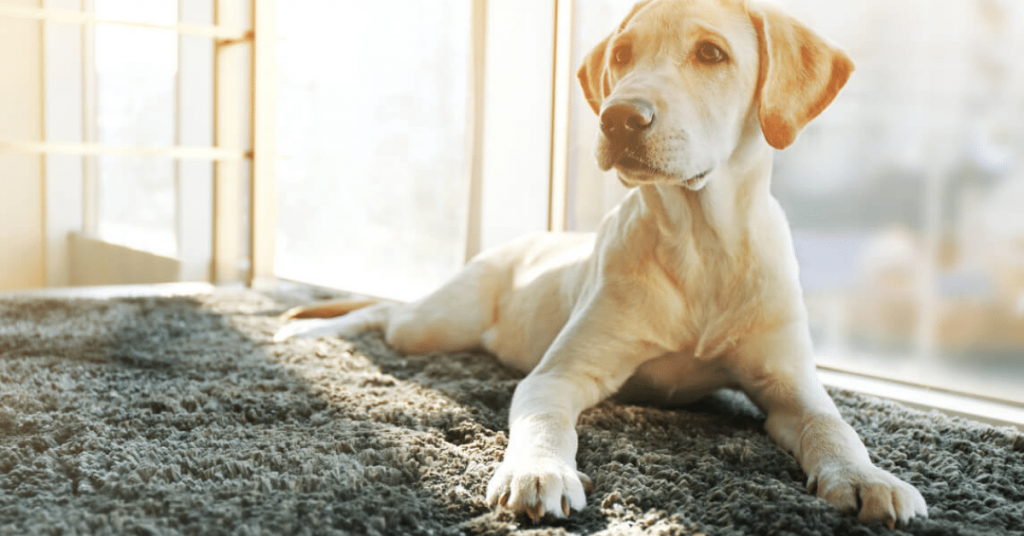
Why is My Dog Eating the Carpet All of a Sudden? How Can I Stop It?
1. The Teeth Replacement
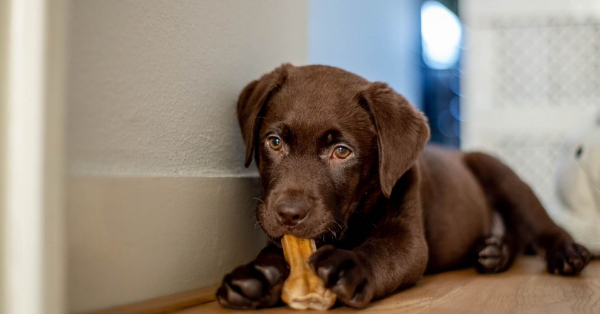
Young puppies usually chew on carpet and other things like cloth and plastic when they’re going through teething. Teething is a months-long process when dogs’ puppy teeth get replaced by adult teeth.
It begins when puppies are 2 weeks old and usually ends at around 8 months of age when all their adult teeth have fully grown. Buying your puppy teething toys can help prevent them from chewing your carpet up and also help reduce the discomfort caused by the growth of new teeth!
This also helps your dog distinguish between objects they can and can’t chew on, in a way, disciplining them.
You could buy them dental chew sticks as they encourage healthy chewing and improve your dog’s dental health. Dog toys like kongs and balls also may help them with getting all their extra energy out!
As a dog owner, it is important to encourage appropriate chewing and discourage inappropriate chewing! Direct your dog’s attention to the object he is supposed to chew and take the forbidden object away. Training puppies at a young age is helpful in ensuring that they grow up to be obedient and friendly dogs.
2.Dog’s Mistaking Carpet for Grass
Sometimes, dogs misunderstand carpet for grass that they usually eat when they feel nauseous and want to regurgitate. In this case, dogs are usually older and have gotten past their teething stage.
A dog trying to eat carpet is probably looking to graze on grass and should be taken out to the park or anywhere else where he can nibble his heart out! Put on your running shoes and take your dog on a run! It’ll be a breath of fresh air for both of you!
3. Lack of Entertainments
Yeah, puppies are bored all the time. More than often, dogs chew on things they aren’t supposed to because of boredom. This is the case especially if your dog is a young puppy. With all that energy inside of him and no outlet, all he can do is chew on things!

Engage your energetic puppy in playtime that includes new and fun activities to tire him out! This not only improves the bond you share with your puppy but also helps redirect his energy to activities that are not chewing up on things, like your carpet.
4. Dog’s Craving for Nonfood Items
Another reason why your dog is eating carpet could be due to a condition called pica. Dogs with this medical condition eat rocks, carpets, plastic and other non-food items which is a sign that your dog is lacking in nutrition.
Pica could also be caused by psychologically obsessive behaviour and other medical issues If you have observed this happening for a while, you need to take your dog to a veterinarian so that they can properly diagnose and start treating your dog. It is good to prevent your dog from choking on non-food items and developing digestive issues as soon as possible!
What Happens if Your Dog Eats a Carpet? Is a Trip to a Vet Necessary?
More than often, dogs start vomiting up whatever they’ve eaten that’s not food. If not, you should keep an eye on your dog’s stool for pieces of carpet. Disgusting, I know, but you also need to keep your eyes peeled for any mucus or blood in the stool. In that case, a trip to the vet it is!
However, if your dog is acting normal, you just need to look for confirmation that the carpet has passed through his system.

Ingesting foreign objects over a long period of time can create blockages in your dog’s digestive tract. A combination of any of these signs requires an immediate trip to the vet: queasiness, swollen belly, vomiting, bowel changes, refusing food, depression, laziness.
Based on a thorough examination and X-rays, if required, the vet can decide whether your dog needs medical intervention or will excrete the pieces of carpet eaten in time.
How Do You Fix Dog-damaged Carpet?
If your dog has totalled your favourite carpet and you want to explore some DIY options to fix it before approaching a pro, this post will provide you with in-depth knowledge on how to do it! Carpets are usually big investments for a homeowner. We understand the anxiety you may be going through while trying to think of ways to patch up this glaring hole in the middle of your living room.
A carpet professional may charge around three times more than what it would cost you to fix a carpet tear yourself. Replacing carpeting is another figure altogether. Read on to find out how you can restore your beloved carpet back to its original glory.
Method 1: Sticking up Strands of Carpet Pile
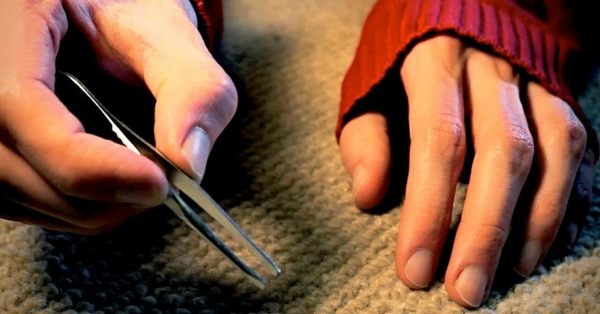
This is the most suitable DIY option to restore your carpet when it has small holes and tears. Saving strands of carpet hair as soon as you find your pet going at it is important as the main intention of using this method to fix your carpet is to glue them back in place with the help of tweezers and some strong waterproof adhesive.
This method only works for small areas of worn-out carpeting as it usually takes a lot of time. You can also take some matching fibres from low-profile areas like under furniture or behind a wardrobe as some irregularity in such areas would usually go unnoticed. Press the carpet fibres in place to ensure that it doesn’t look tacky or out of place. Lie down and look at the patched-up area from the side.
You should be able to tell if it looks smooth. Use sewing shears or cloth scissors to cut any extra hair sticking up. Voila! Your carpet looks even again!

Method 2: Using Heat-Activated Tape for the Seam Tear
Pets may sometimes chew up that part of your carpet that has seams lying underneath the hair. Since seams hold the base fabric and hairs together, this can be a problem for carpet owners.
To fix this, you can cut a piece of heat-activated tape that’s slightly longer than the torn area and place it along the edge of the tear underneath the carpet. Firmly press on the area with a steam iron to ensure it’s sealed well. You can now rest knowing that the seam tear has been taken care of!
Alternatively, fold the carpet back as much as possible and apply a good amount of latex adhesive along the bottom edge of the tear. Pressing firmly on it will push it into place.
Method 3: Bridging the Carpet Gap by Sewing it
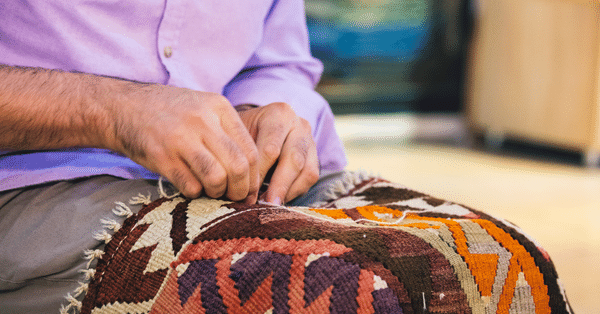
This method of patching up a torn carpet is most useful for slightly bigger tears. To begin, use a chisel to fold up a corner of the carpet from the tack strips closest to the damage. Fold it well enough to make the entire torn area visible and start sewing 1-inch long stitches across the tear on the back of the carpet, closing 1/4th of an inch of the tear at a time.
A matching colour thread must be used for sewing to ensure that the stitches remain invisible on the top. Keep examining the top surface of the carpet after every couple of stitches to make sure of this.
After sewing across the tear on the back of the carpet, apply an adequate amount of latex adhesive along the stitches. Press hard on the area to make sure it stays in place and roll the carpet back. Reattach it to the tack strips with a knee-kicker or a carpet stretcher.
Method 4: Fixing the Carpet Tear by Putting a Patch
For larger areas of damage, patching is the best option to fix a carpet with tears. If done well, this method can look seamless, with absolutely no evidence of damage and can help bring your carpet back to how it looked before your dog decided to chew on it! Remnants from the initial carpet installation can be used to help. In case you don’t have any remaining carpeting from the time of installation, you can cut out a small piece of carpet fabric from any area in your house that’s not visible, like under furniture or behind a closet. Make sure you later replace the patch in that area with an exact patch from a store or your landlord if you live in a rented apartment.
Step 1
Place a circular container on top of the damaged area that is bigger than the damage, so as to create a boundary around the tear. Use a pencil or chalk to draw an outline around the container and measure it carefully, whether it is the radius or the circumference of the circle.
Step 2
After this, take your carpet fabric out and use a sharp utility or carpet knife to cut the shape out and trim it to match the shape outlined on your floor. This is a very important step that ensures smooth and even patchwork, undetectable to even the sharpest eyes. Place the cutout on top of the carpet to compare and also to find out the direction of the carpet’s nap.
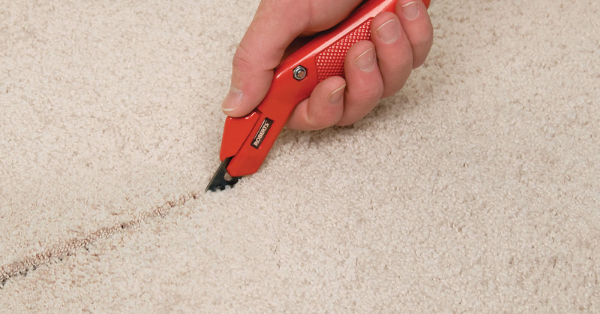
Step 3
Now that your repair piece is ready, use the container you previously used and apply consistent pressure while placing it on the outline. This will help create an indentation on the surface of the carpet that you can use to help you cut carefully. Use the sharp knife to carefully cut along the outline and the indentation.
Step 4
Cut a circular piece of single-sided carpet tape that is at least 2-3 inches wider than the repair piece in diameter. Cut the piece along the diameter to create two semi-circles. Insert the pieces carefully inside the hole and ensure that they’re placed right underneath with extra taping around the hole. Press firmly and smoothen out the area so that it sticks on to the surface properly. Be very patient because the tape’s sticky quality can be a challenge.
Step 5
Once you’re sure the carpet tape is in place, take the repair piece and hold it above the hole while also keeping in mind the nap’s direction. Insert the piece in the hole and press firmly with your palms to ensure proper insertion and sticking. You also may have to apply extra force around the cutout with your fingertips so that it doesn’t stick out in prominence.
Step 6
Even out differences, if any, with the help of scissors or napping shears and make sure that the repair piece fibres are on the same level as the others. Fluff that area of your carpet well to restore its original look. You can also run your vacuum cleaner over the patched area. This will help the piece blend well with the rest of the carpet and no one will be able to notice the patchwork!
Conclusion
And that’s it! I hope this post really helped you understand the four most common reasons why dogs might be eating your carpet (teething, grazing, boredom and pica). But most importantly… I hope your dog is doing ok!
Most of the time dogs won’t suffer from eating carpet, but make sure that he/she is all right first! And then make sure to fix your carpet correctly. Perhaps after fixing your carpet you might need to have it cleaned. Did you know that 85% of pet owners don’t clean their carpets as often as it’s recommended by the IICRC?
If you’d like to have your carpets cleaned, check our post on How To Find the Best Carpet Cleaners in Your Area! I’m sure you’ll find it very interesting.
